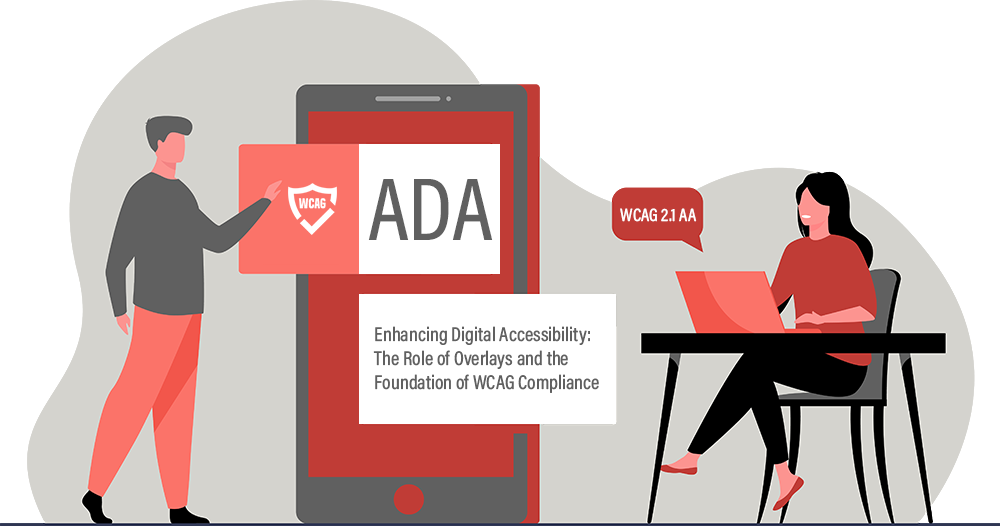Enhancing Digital Accessibility
Enhancing Digital Accessibility: The Role of Overlays and the Foundation of WCAG Compliance
In today’s digital marketplace, ensuring website accessibility is not just a legal requirement but a fundamental aspect of creating an inclusive user experience.
While accessibility overlays offer potential benefits, they should be viewed as a supplementary tool, not a replacement for robust, underlying accessibility.

Understanding Web Accessibility Overlays
Web accessibility overlays are third-party tools, typically implemented via JavaScript, designed to modify the front-end of a website to improve accessibility. These tools range from simple text-to-speech functionalities (pioneered by solutions like Readspeaker and Browsealoud) to more complex interfaces that adjust font sizes, colors, and attempt to automate accessibility repairs.
Examples of accessibility overlay solutions include:
- Equally Ai / Equally AI Official Website
- AccessiBe / AccessiBe Official Website
- AudioEye / AudioEye Official Website
- UserWay / UserWay Official Website
- EqualWeb / EqualWeb Official Website
- And many others…
The Strategic Role of Overlays: Supplementing, Not Replacing, Core Accessibility
While overlays can provide helpful features, they are most effective when built upon a solid foundation of WCAG 2.1 Level AA compliance. Think of them as the finishing touches, not the structural support.
Strengths and Appropriate Use of Overlay Widgets
- User Customization: Overlays can offer quick, on-the-fly adjustments to contrast, text size, and other display settings, potentially benefiting users who need immediate modifications.
- Supplementary tools: They can add tools that website owners have not thought of, or do not have the resources to add.
- Temporary fixes: Overlays can be helpful to provide a level of access while a website is going through a full accessibility remediation.
However, it’s crucial to acknowledge:
- Redundancy: Many users with disabilities already utilize assistive technologies or browser settings that provide similar functionalities.
- Limited scope: Overlays can not fix every accessibility issue.
The Critical Foundation of eCommerce Accessibility
In today’s digital landscape, eCommerce accessibility is no longer optional – it’s a legal requirement, a business imperative, and a fundamental aspect of ethical online commerce. But achieving true, comprehensive WCAG 2.1 AA compliance goes far beyond simply adding an accessibility overlay to an existing website.
To truly protect your business and provide an inclusive experience for all potential customers, you need a solid foundation: an eCommerce platform meticulously designed and built from the ground up with accessibility as a core principle. This isn’t just about avoiding lawsuits; it’s about creating a welcoming and usable online store for everyone, ensuring that *all* users, regardless of ability, can seamlessly navigate, browse, and make purchases.
Overlays, while potentially helpful for some users, cannot fundamentally alter the underlying code structure of a website. For eCommerce businesses, where the user experience is paramount and legal compliance is non-negotiable, starting with an accessible foundation is essential. EnterpriStore offers a solution by providing an eCommerce platform built with WCAG 2.1 AA source code compliance as a core principle, ensuring that accessibility is ingrained from the very beginning.
Automated Repair: Potential and Limitations
Some overlays claim to automatically repair accessibility issues. While these tools can address certain problems, they have significant limitations:
- Inaccurate Alt Text: Automated generation of alternative text for images is often unreliable, potentially providing misleading or useless information.
- Form Accessibility Challenges: Repairing form labels, error handling, and keyboard navigation is complex and prone to errors.
- Dynamic Content Issues: Modern web applications using frameworks like React, Angular, or Vue can present challenges for overlays, as content changes may occur independently of the overlay’s script.
- Performance Impact: Overlays can sometimes slow down page load times or cause unexpected behavior for assistive technology users.
- Limited File Support: Overlays generally cannot repair accessibility issues within Flash, Java, Silverlight, PDF, HTML5 Canvas, SVG, or media files.
WCAG Compliance: The Essential Foundation
Achieving true accessibility requires more than just an overlay. WCAG 2.1 Level AA compliance should be the primary objective. Overlays can assist in addressing specific aspects, but they cannot guarantee full compliance.
- Comprehensive Accessibility: Conformance to WCAG standards ensures that websites are fundamentally accessible, benefiting all users, including those with disabilities.
- Legal Protection: Achieving WCAG compliance can help mitigate legal risks associated with accessibility lawsuits.
- Improved SEO: Accessible websites often have better structure and usability, which can positively impact search engine rankings.
Privacy Considerations:
- Sensitive Data: Overlays that detect assistive technology usage may inadvertently expose sensitive user information, raising privacy concerns.
- Data Tracking: Some overlays may track user preferences across websites, potentially violating privacy regulations like GDPR and CCPA.
- Transparency and Consent: It’s essential to ensure that users are informed about data collection practices and have the ability to opt out.
Best Practices for E-commerce Accessibility
- Prioritize WCAG 2.1 Level AA Compliance: Conduct thorough accessibility audits and remediate any identified issues.
- Consider Overlays as Supplements: Use overlays to enhance user experience, not as a substitute for core accessibility.
- Ensure Privacy Compliance: Be transparent about data collection and provide users with control over their privacy.
- Regular Testing and Updates: Continuously monitor and test your website’s accessibility, and keep your overlay and core code updated.
- User Feedback: Gather feedback from users with disabilities to identify and address any remaining accessibility barriers.
- SEO Optimization: Use proper semantic HTML, alt text, and keyboard navigation to improve both accessibility and SEO.
Ready to Make Your eCommerce Site Truly Accessible and Inclusive?
Learn how our ecommerce solution ensures accessibility and meets industry standards
Request a demo to see how Equally AI enhances accessibility and user experience
Contact us today for a comprehensive quotation to make your ecommerce or WordPress site WCAG 2.1 compliant
